Structural Engineer Resume Examples

Jul 18, 2024
|
12 min read
Build a strong foundation with your structural engineer resume: how to highlight your skills, qualifications, and experience to stand out in the industry, ensuring your application stands tall.
Rated by 348 people
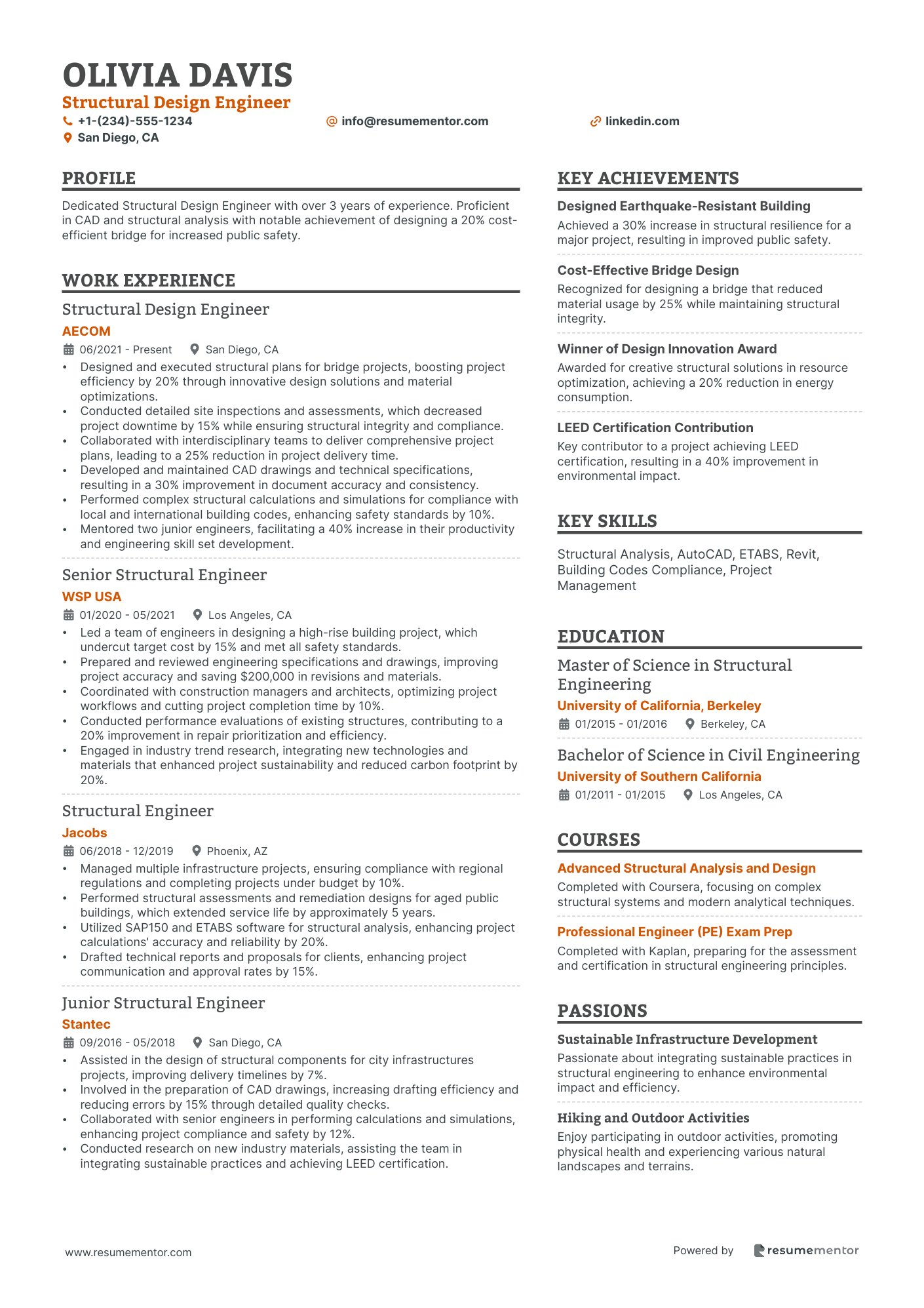
Structural Design Engineer
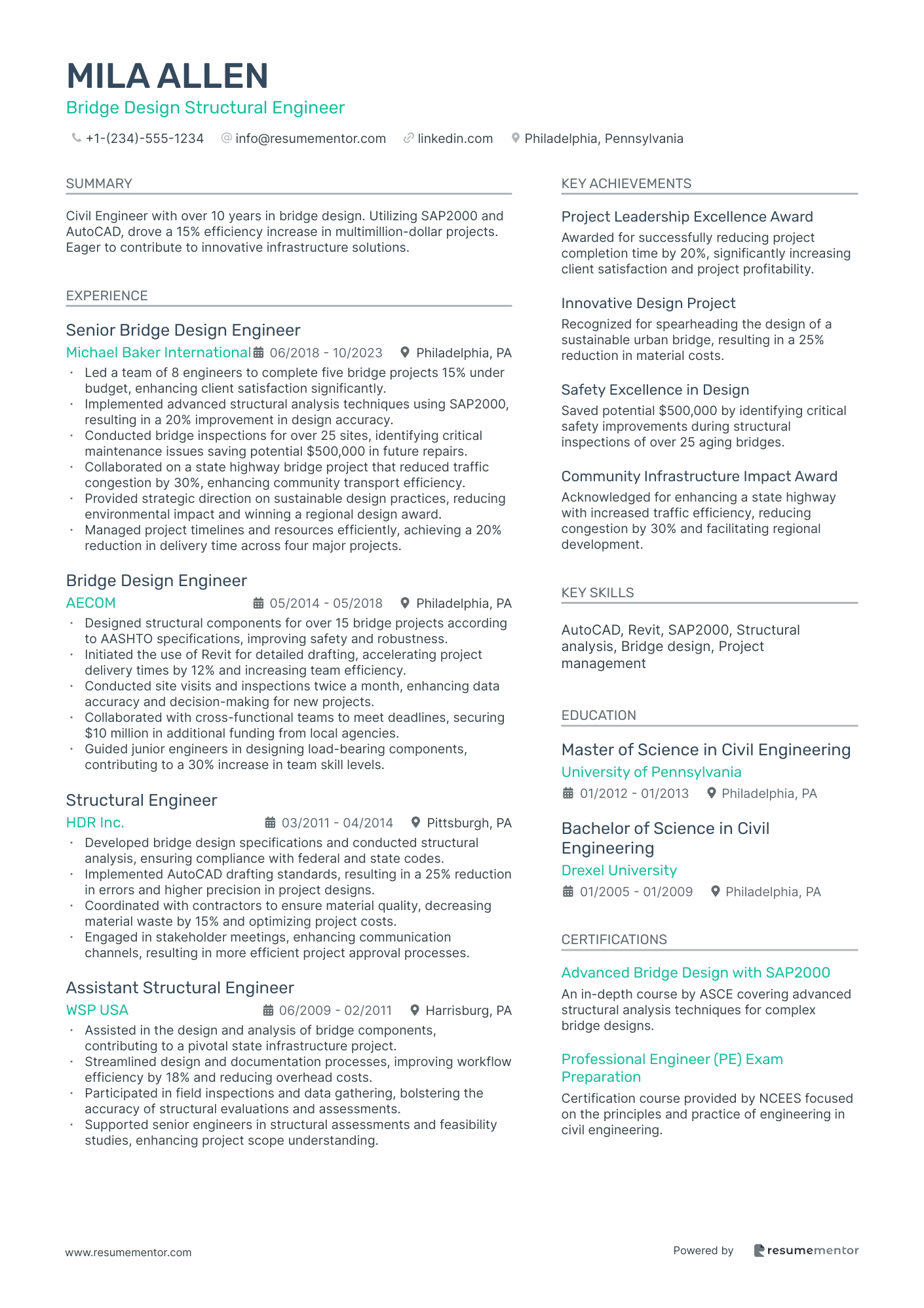
Bridge Design Structural Engineer
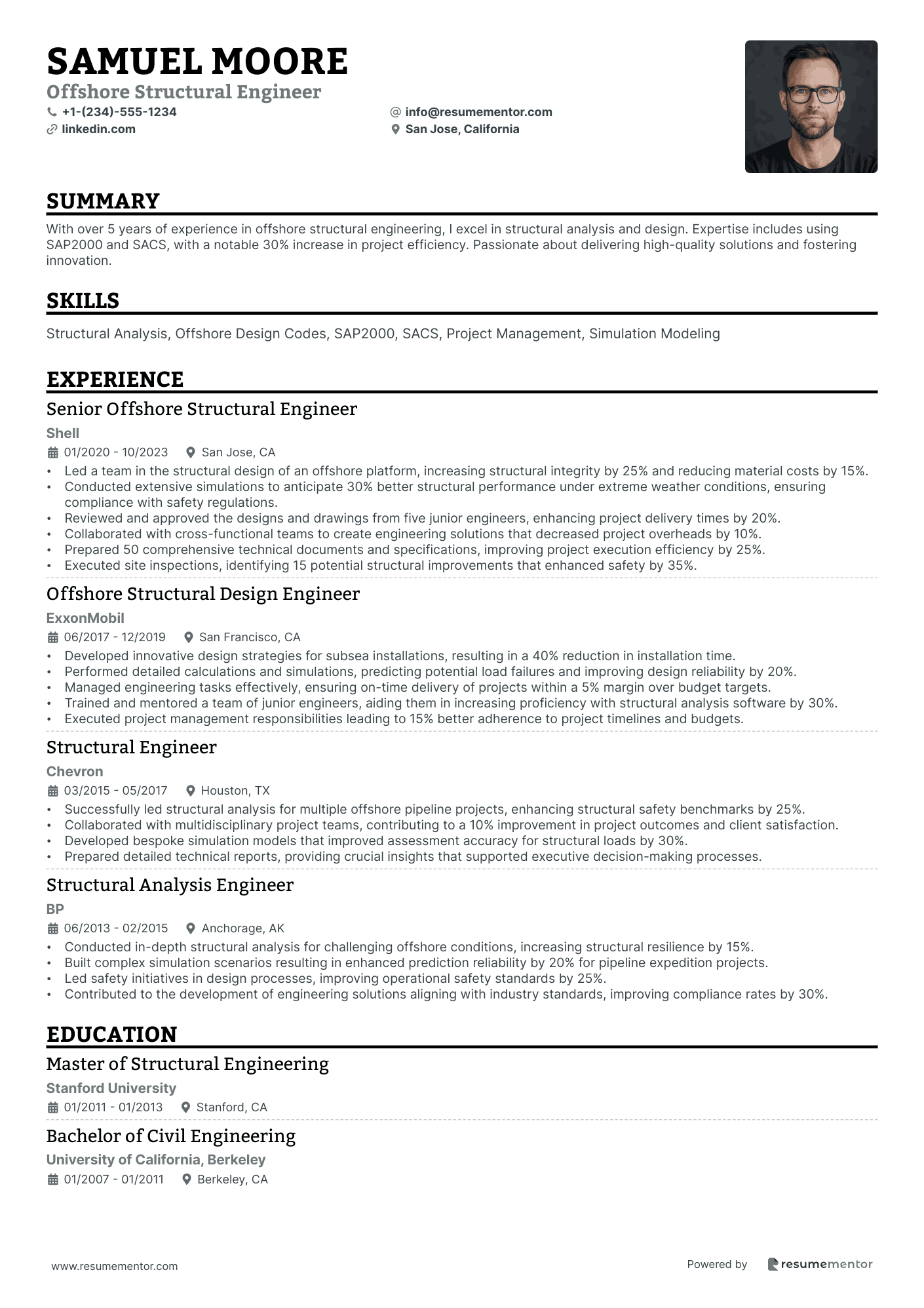
Offshore Structural Engineer
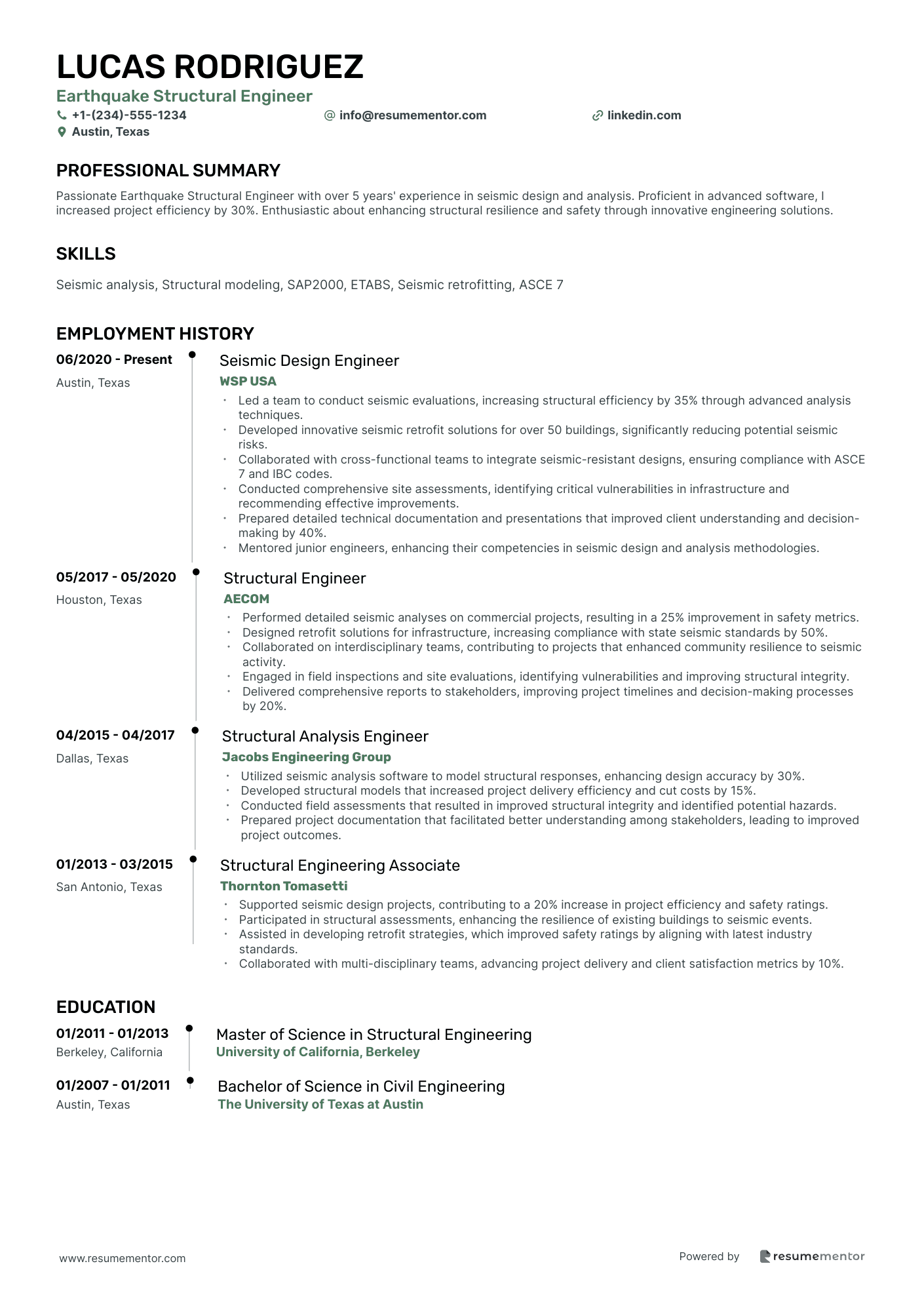
Earthquake Structural Engineer
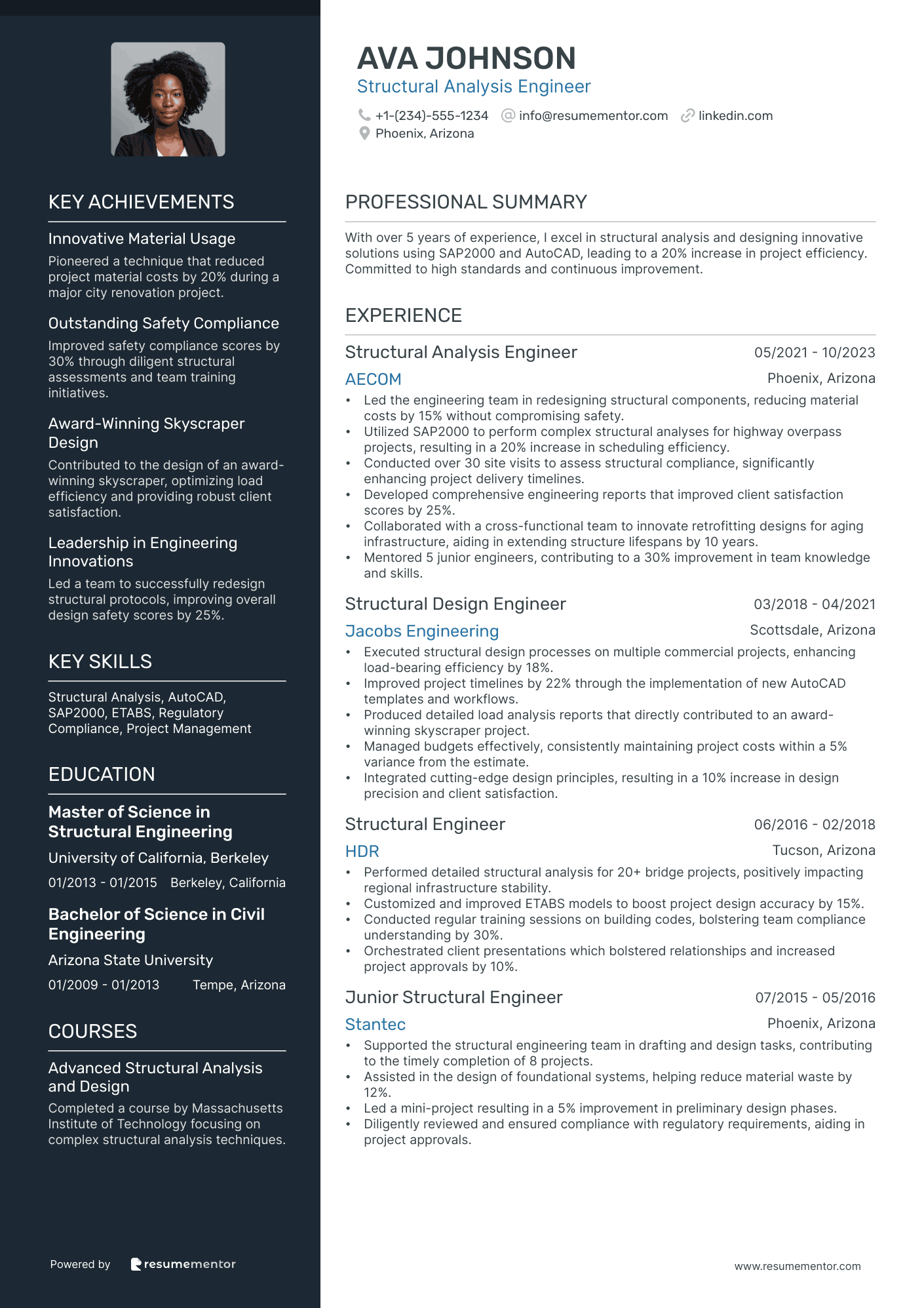
Structural Analysis Engineer
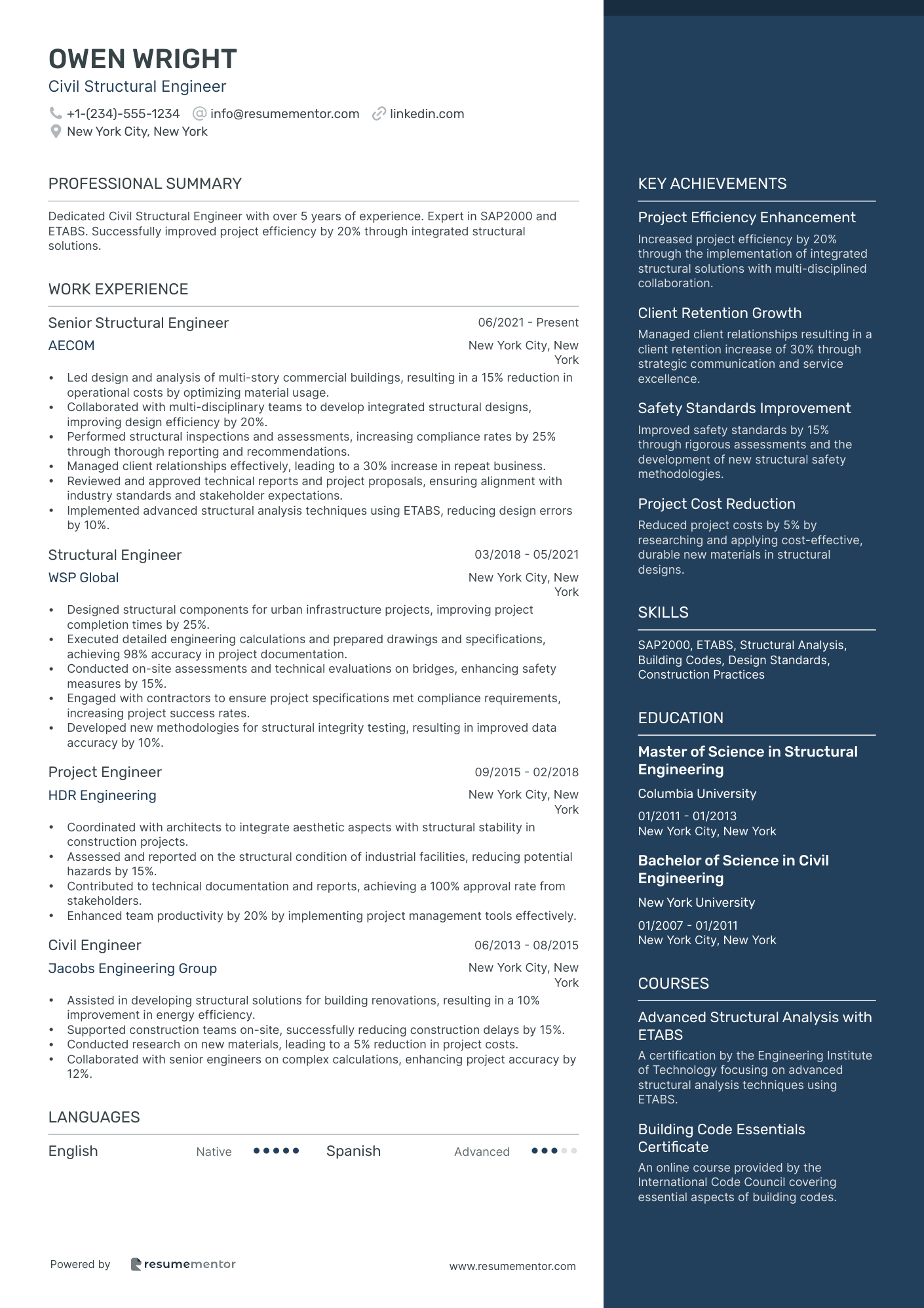
Civil Structural Engineer
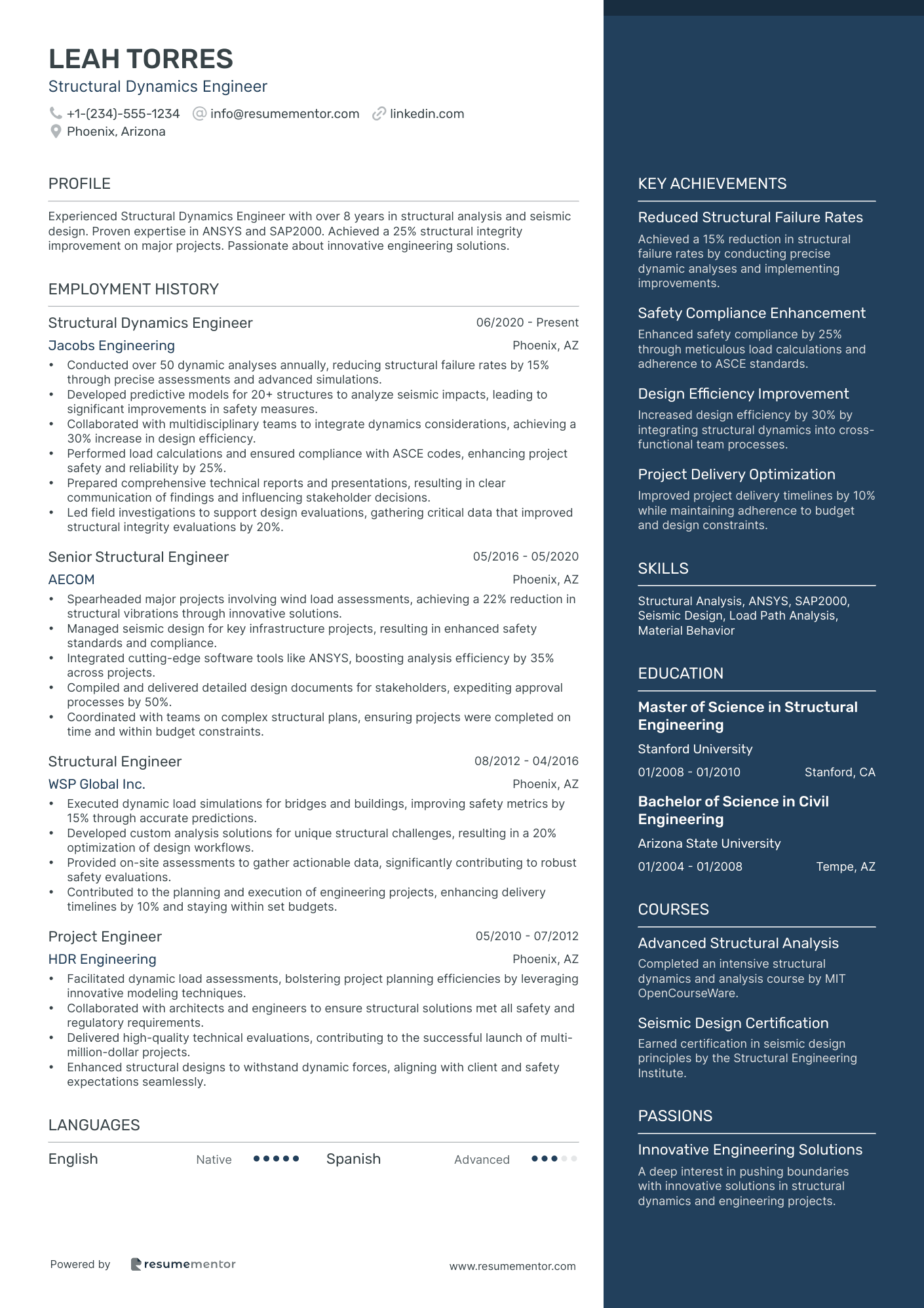
Structural Dynamics Engineer
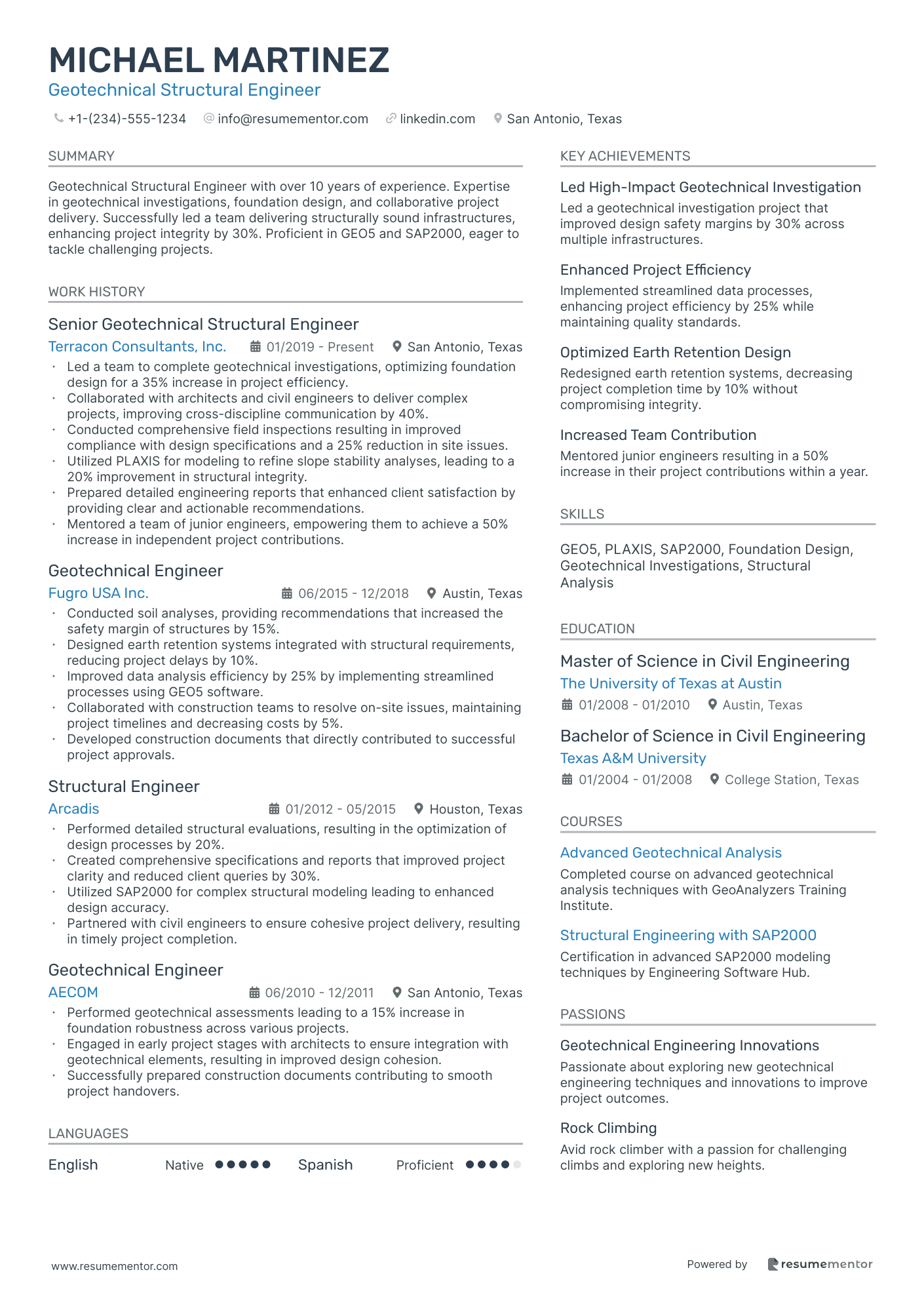
Geotechnical Structural Engineer
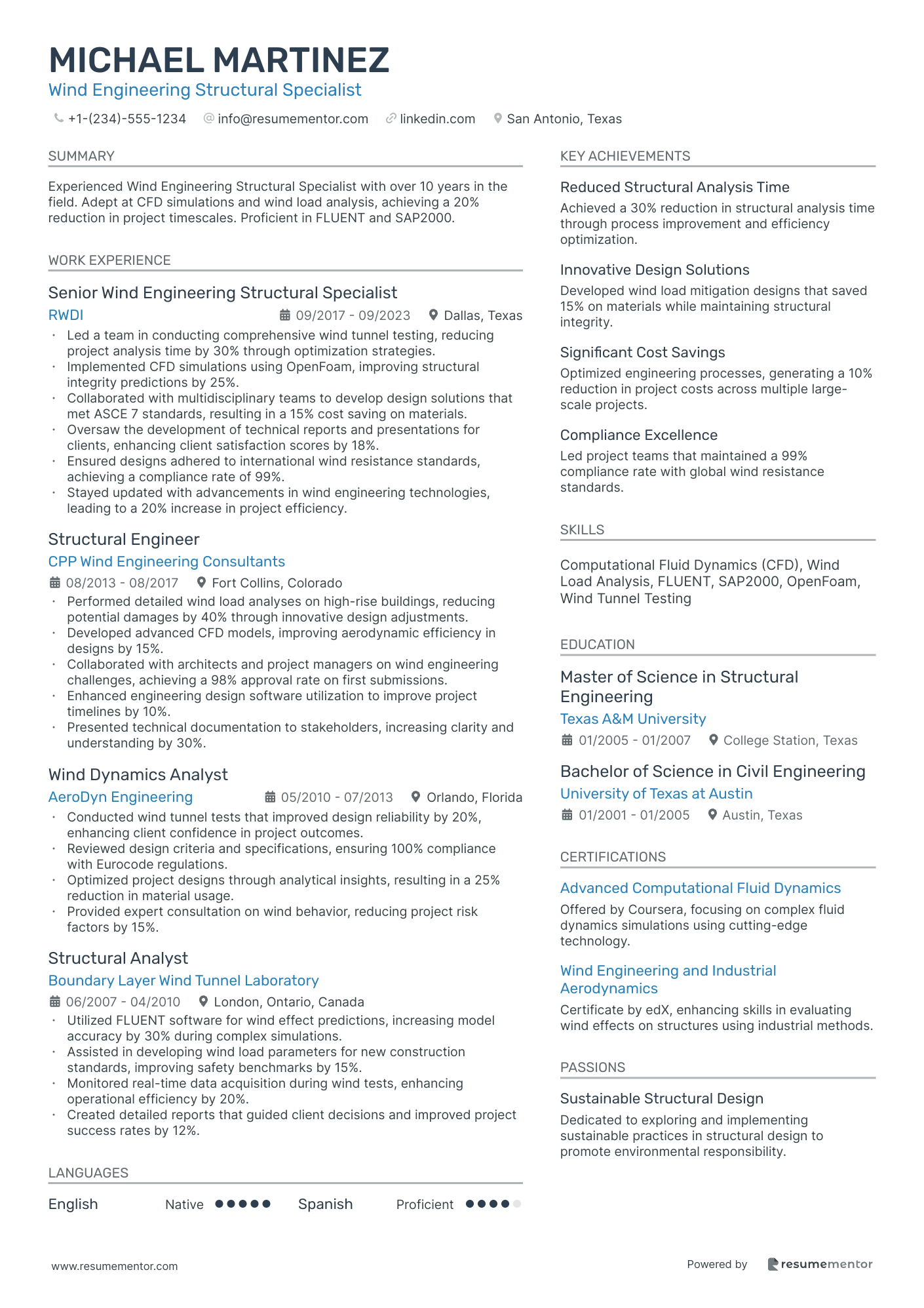
Wind Engineering Structural Specialist
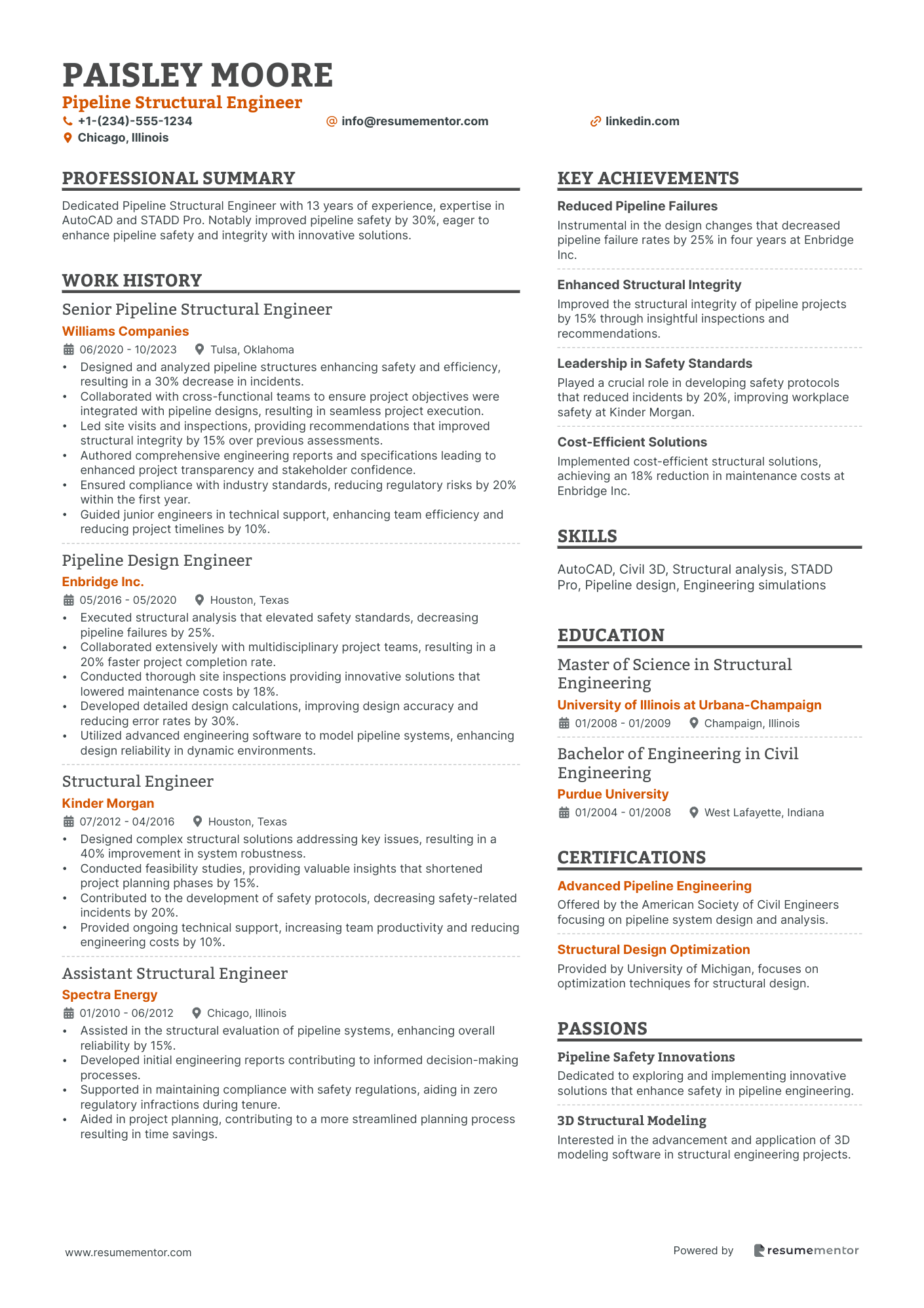
Pipeline Structural Engineer

Structural Design Engineer resume sample
- •Designed and executed structural plans for bridge projects, boosting project efficiency by 20% through innovative design solutions and material optimizations.
- •Conducted detailed site inspections and assessments, which decreased project downtime by 15% while ensuring structural integrity and compliance.
- •Collaborated with interdisciplinary teams to deliver comprehensive project plans, leading to a 25% reduction in project delivery time.
- •Developed and maintained CAD drawings and technical specifications, resulting in a 30% improvement in document accuracy and consistency.
- •Performed complex structural calculations and simulations for compliance with local and international building codes, enhancing safety standards by 10%.
- •Mentored two junior engineers, facilitating a 40% increase in their productivity and engineering skill set development.
- •Led a team of engineers in designing a high-rise building project, which undercut target cost by 15% and met all safety standards.
- •Prepared and reviewed engineering specifications and drawings, improving project accuracy and saving $200,000 in revisions and materials.
- •Coordinated with construction managers and architects, optimizing project workflows and cutting project completion time by 10%.
- •Conducted performance evaluations of existing structures, contributing to a 20% improvement in repair prioritization and efficiency.
- •Engaged in industry trend research, integrating new technologies and materials that enhanced project sustainability and reduced carbon footprint by 20%.
- •Managed multiple infrastructure projects, ensuring compliance with regional regulations and completing projects under budget by 10%.
- •Performed structural assessments and remediation designs for aged public buildings, which extended service life by approximately 5 years.
- •Utilized SAP150 and ETABS software for structural analysis, enhancing project calculations' accuracy and reliability by 20%.
- •Drafted technical reports and proposals for clients, enhancing project communication and approval rates by 15%.
- •Assisted in the design of structural components for city infrastructures projects, improving delivery timelines by 7%.
- •Involved in the preparation of CAD drawings, increasing drafting efficiency and reducing errors by 15% through detailed quality checks.
- •Collaborated with senior engineers in performing calculations and simulations, enhancing project compliance and safety by 12%.
- •Conducted research on new industry materials, assisting the team in integrating sustainable practices and achieving LEED certification.
Bridge Design Structural Engineer resume sample
- •Led a team of 8 engineers to complete five bridge projects 15% under budget, enhancing client satisfaction significantly.
- •Implemented advanced structural analysis techniques using SAP2000, resulting in a 20% improvement in design accuracy.
- •Conducted bridge inspections for over 25 sites, identifying critical maintenance issues saving potential $500,000 in future repairs.
- •Collaborated on a state highway bridge project that reduced traffic congestion by 30%, enhancing community transport efficiency.
- •Provided strategic direction on sustainable design practices, reducing environmental impact and winning a regional design award.
- •Managed project timelines and resources efficiently, achieving a 20% reduction in delivery time across four major projects.
- •Designed structural components for over 15 bridge projects according to AASHTO specifications, improving safety and robustness.
- •Initiated the use of Revit for detailed drafting, accelerating project delivery times by 12% and increasing team efficiency.
- •Conducted site visits and inspections twice a month, enhancing data accuracy and decision-making for new projects.
- •Collaborated with cross-functional teams to meet deadlines, securing $10 million in additional funding from local agencies.
- •Guided junior engineers in designing load-bearing components, contributing to a 30% increase in team skill levels.
- •Developed bridge design specifications and conducted structural analysis, ensuring compliance with federal and state codes.
- •Implemented AutoCAD drafting standards, resulting in a 25% reduction in errors and higher precision in project designs.
- •Coordinated with contractors to ensure material quality, decreasing material waste by 15% and optimizing project costs.
- •Engaged in stakeholder meetings, enhancing communication channels, resulting in more efficient project approval processes.
- •Assisted in the design and analysis of bridge components, contributing to a pivotal state infrastructure project.
- •Streamlined design and documentation processes, improving workflow efficiency by 18% and reducing overhead costs.
- •Participated in field inspections and data gathering, bolstering the accuracy of structural evaluations and assessments.
- •Supported senior engineers in structural assessments and feasibility studies, enhancing project scope understanding.
Offshore Structural Engineer resume sample
- •Led a team in the structural design of an offshore platform, increasing structural integrity by 25% and reducing material costs by 15%.
- •Conducted extensive simulations to anticipate 30% better structural performance under extreme weather conditions, ensuring compliance with safety regulations.
- •Reviewed and approved the designs and drawings from five junior engineers, enhancing project delivery times by 20%.
- •Collaborated with cross-functional teams to create engineering solutions that decreased project overheads by 10%.
- •Prepared 50 comprehensive technical documents and specifications, improving project execution efficiency by 25%.
- •Executed site inspections, identifying 15 potential structural improvements that enhanced safety by 35%.
- •Developed innovative design strategies for subsea installations, resulting in a 40% reduction in installation time.
- •Performed detailed calculations and simulations, predicting potential load failures and improving design reliability by 20%.
- •Managed engineering tasks effectively, ensuring on-time delivery of projects within a 5% margin over budget targets.
- •Trained and mentored a team of junior engineers, aiding them in increasing proficiency with structural analysis software by 30%.
- •Executed project management responsibilities leading to 15% better adherence to project timelines and budgets.
- •Successfully led structural analysis for multiple offshore pipeline projects, enhancing structural safety benchmarks by 25%.
- •Collaborated with multidisciplinary project teams, contributing to a 10% improvement in project outcomes and client satisfaction.
- •Developed bespoke simulation models that improved assessment accuracy for structural loads by 30%.
- •Prepared detailed technical reports, providing crucial insights that supported executive decision-making processes.
- •Conducted in-depth structural analysis for challenging offshore conditions, increasing structural resilience by 15%.
- •Built complex simulation scenarios resulting in enhanced prediction reliability by 20% for pipeline expedition projects.
- •Led safety initiatives in design processes, improving operational safety standards by 25%.
- •Contributed to the development of engineering solutions aligning with industry standards, improving compliance rates by 30%.
Earthquake Structural Engineer resume sample
- •Led a team to conduct seismic evaluations, increasing structural efficiency by 35% through advanced analysis techniques.
- •Developed innovative seismic retrofit solutions for over 50 buildings, significantly reducing potential seismic risks.
- •Collaborated with cross-functional teams to integrate seismic-resistant designs, ensuring compliance with ASCE 7 and IBC codes.
- •Conducted comprehensive site assessments, identifying critical vulnerabilities in infrastructure and recommending effective improvements.
- •Prepared detailed technical documentation and presentations that improved client understanding and decision-making by 40%.
- •Mentored junior engineers, enhancing their competencies in seismic design and analysis methodologies.
- •Performed detailed seismic analyses on commercial projects, resulting in a 25% improvement in safety metrics.
- •Designed retrofit solutions for infrastructure, increasing compliance with state seismic standards by 50%.
- •Collaborated on interdisciplinary teams, contributing to projects that enhanced community resilience to seismic activity.
- •Engaged in field inspections and site evaluations, identifying vulnerabilities and improving structural integrity.
- •Delivered comprehensive reports to stakeholders, improving project timelines and decision-making processes by 20%.
- •Utilized seismic analysis software to model structural responses, enhancing design accuracy by 30%.
- •Developed structural models that increased project delivery efficiency and cut costs by 15%.
- •Conducted field assessments that resulted in improved structural integrity and identified potential hazards.
- •Prepared project documentation that facilitated better understanding among stakeholders, leading to improved project outcomes.
- •Supported seismic design projects, contributing to a 20% increase in project efficiency and safety ratings.
- •Participated in structural assessments, enhancing the resilience of existing buildings to seismic events.
- •Assisted in developing retrofit strategies, which improved safety ratings by aligning with latest industry standards.
- •Collaborated with multi-disciplinary teams, advancing project delivery and client satisfaction metrics by 10%.
Structural Analysis Engineer resume sample
- •Led the engineering team in redesigning structural components, reducing material costs by 15% without compromising safety.
- •Utilized SAP2000 to perform complex structural analyses for highway overpass projects, resulting in a 20% increase in scheduling efficiency.
- •Conducted over 30 site visits to assess structural compliance, significantly enhancing project delivery timelines.
- •Developed comprehensive engineering reports that improved client satisfaction scores by 25%.
- •Collaborated with a cross-functional team to innovate retrofitting designs for aging infrastructure, aiding in extending structure lifespans by 10 years.
- •Mentored 5 junior engineers, contributing to a 30% improvement in team knowledge and skills.
- •Executed structural design processes on multiple commercial projects, enhancing load-bearing efficiency by 18%.
- •Improved project timelines by 22% through the implementation of new AutoCAD templates and workflows.
- •Produced detailed load analysis reports that directly contributed to an award-winning skyscraper project.
- •Managed budgets effectively, consistently maintaining project costs within a 5% variance from the estimate.
- •Integrated cutting-edge design principles, resulting in a 10% increase in design precision and client satisfaction.
- •Performed detailed structural analysis for 20+ bridge projects, positively impacting regional infrastructure stability.
- •Customized and improved ETABS models to boost project design accuracy by 15%.
- •Conducted regular training sessions on building codes, bolstering team compliance understanding by 30%.
- •Orchestrated client presentations which bolstered relationships and increased project approvals by 10%.
- •Supported the structural engineering team in drafting and design tasks, contributing to the timely completion of 8 projects.
- •Assisted in the design of foundational systems, helping reduce material waste by 12%.
- •Led a mini-project resulting in a 5% improvement in preliminary design phases.
- •Diligently reviewed and ensured compliance with regulatory requirements, aiding in project approvals.
Civil Structural Engineer resume sample
- •Led design and analysis of multi-story commercial buildings, resulting in a 15% reduction in operational costs by optimizing material usage.
- •Collaborated with multi-disciplinary teams to develop integrated structural designs, improving design efficiency by 20%.
- •Performed structural inspections and assessments, increasing compliance rates by 25% through thorough reporting and recommendations.
- •Managed client relationships effectively, leading to a 30% increase in repeat business.
- •Reviewed and approved technical reports and project proposals, ensuring alignment with industry standards and stakeholder expectations.
- •Implemented advanced structural analysis techniques using ETABS, reducing design errors by 10%.
- •Designed structural components for urban infrastructure projects, improving project completion times by 25%.
- •Executed detailed engineering calculations and prepared drawings and specifications, achieving 98% accuracy in project documentation.
- •Conducted on-site assessments and technical evaluations on bridges, enhancing safety measures by 15%.
- •Engaged with contractors to ensure project specifications met compliance requirements, increasing project success rates.
- •Developed new methodologies for structural integrity testing, resulting in improved data accuracy by 10%.
- •Coordinated with architects to integrate aesthetic aspects with structural stability in construction projects.
- •Assessed and reported on the structural condition of industrial facilities, reducing potential hazards by 15%.
- •Contributed to technical documentation and reports, achieving a 100% approval rate from stakeholders.
- •Enhanced team productivity by 20% by implementing project management tools effectively.
- •Assisted in developing structural solutions for building renovations, resulting in a 10% improvement in energy efficiency.
- •Supported construction teams on-site, successfully reducing construction delays by 15%.
- •Conducted research on new materials, leading to a 5% reduction in project costs.
- •Collaborated with senior engineers on complex calculations, enhancing project accuracy by 12%.
Structural Dynamics Engineer resume sample
- •Conducted over 50 dynamic analyses annually, reducing structural failure rates by 15% through precise assessments and advanced simulations.
- •Developed predictive models for 20+ structures to analyze seismic impacts, leading to significant improvements in safety measures.
- •Collaborated with multidisciplinary teams to integrate dynamics considerations, achieving a 30% increase in design efficiency.
- •Performed load calculations and ensured compliance with ASCE codes, enhancing project safety and reliability by 25%.
- •Prepared comprehensive technical reports and presentations, resulting in clear communication of findings and influencing stakeholder decisions.
- •Led field investigations to support design evaluations, gathering critical data that improved structural integrity evaluations by 20%.
- •Spearheaded major projects involving wind load assessments, achieving a 22% reduction in structural vibrations through innovative solutions.
- •Managed seismic design for key infrastructure projects, resulting in enhanced safety standards and compliance.
- •Integrated cutting-edge software tools like ANSYS, boosting analysis efficiency by 35% across projects.
- •Compiled and delivered detailed design documents for stakeholders, expediting approval processes by 50%.
- •Coordinated with teams on complex structural plans, ensuring projects were completed on time and within budget constraints.
- •Executed dynamic load simulations for bridges and buildings, improving safety metrics by 15% through accurate predictions.
- •Developed custom analysis solutions for unique structural challenges, resulting in a 20% optimization of design workflows.
- •Provided on-site assessments to gather actionable data, significantly contributing to robust safety evaluations.
- •Contributed to the planning and execution of engineering projects, enhancing delivery timelines by 10% and staying within set budgets.
- •Facilitated dynamic load assessments, bolstering project planning efficiencies by leveraging innovative modeling techniques.
- •Collaborated with architects and engineers to ensure structural solutions met all safety and regulatory requirements.
- •Delivered high-quality technical evaluations, contributing to the successful launch of multi-million-dollar projects.
- •Enhanced structural designs to withstand dynamic forces, aligning with client and safety expectations seamlessly.
Geotechnical Structural Engineer resume sample
- •Led a team to complete geotechnical investigations, optimizing foundation design for a 35% increase in project efficiency.
- •Collaborated with architects and civil engineers to deliver complex projects, improving cross-discipline communication by 40%.
- •Conducted comprehensive field inspections resulting in improved compliance with design specifications and a 25% reduction in site issues.
- •Utilized PLAXIS for modeling to refine slope stability analyses, leading to a 20% improvement in structural integrity.
- •Prepared detailed engineering reports that enhanced client satisfaction by providing clear and actionable recommendations.
- •Mentored a team of junior engineers, empowering them to achieve a 50% increase in independent project contributions.
- •Conducted soil analyses, providing recommendations that increased the safety margin of structures by 15%.
- •Designed earth retention systems integrated with structural requirements, reducing project delays by 10%.
- •Improved data analysis efficiency by 25% by implementing streamlined processes using GEO5 software.
- •Collaborated with construction teams to resolve on-site issues, maintaining project timelines and decreasing costs by 5%.
- •Developed construction documents that directly contributed to successful project approvals.
- •Performed detailed structural evaluations, resulting in the optimization of design processes by 20%.
- •Created comprehensive specifications and reports that improved project clarity and reduced client queries by 30%.
- •Utilized SAP2000 for complex structural modeling leading to enhanced design accuracy.
- •Partnered with civil engineers to ensure cohesive project delivery, resulting in timely project completion.
- •Performed geotechnical assessments leading to a 15% increase in foundation robustness across various projects.
- •Engaged in early project stages with architects to ensure integration with geotechnical elements, resulting in improved design cohesion.
- •Successfully prepared construction documents contributing to smooth project handovers.
Wind Engineering Structural Specialist resume sample
- •Led a team in conducting comprehensive wind tunnel testing, reducing project analysis time by 30% through optimization strategies.
- •Implemented CFD simulations using OpenFoam, improving structural integrity predictions by 25%.
- •Collaborated with multidisciplinary teams to develop design solutions that met ASCE 7 standards, resulting in a 15% cost saving on materials.
- •Oversaw the development of technical reports and presentations for clients, enhancing client satisfaction scores by 18%.
- •Ensured designs adhered to international wind resistance standards, achieving a compliance rate of 99%.
- •Stayed updated with advancements in wind engineering technologies, leading to a 20% increase in project efficiency.
- •Performed detailed wind load analyses on high-rise buildings, reducing potential damages by 40% through innovative design adjustments.
- •Developed advanced CFD models, improving aerodynamic efficiency in designs by 15%.
- •Collaborated with architects and project managers on wind engineering challenges, achieving a 98% approval rate on first submissions.
- •Enhanced engineering design software utilization to improve project timelines by 10%.
- •Presented technical documentation to stakeholders, increasing clarity and understanding by 30%.
- •Conducted wind tunnel tests that improved design reliability by 20%, enhancing client confidence in project outcomes.
- •Reviewed design criteria and specifications, ensuring 100% compliance with Eurocode regulations.
- •Optimized project designs through analytical insights, resulting in a 25% reduction in material usage.
- •Provided expert consultation on wind behavior, reducing project risk factors by 15%.
- •Utilized FLUENT software for wind effect predictions, increasing model accuracy by 30% during complex simulations.
- •Assisted in developing wind load parameters for new construction standards, improving safety benchmarks by 15%.
- •Monitored real-time data acquisition during wind tests, enhancing operational efficiency by 20%.
- •Created detailed reports that guided client decisions and improved project success rates by 12%.
Pipeline Structural Engineer resume sample
- •Designed and analyzed pipeline structures enhancing safety and efficiency, resulting in a 30% decrease in incidents.
- •Collaborated with cross-functional teams to ensure project objectives were integrated with pipeline designs, resulting in seamless project execution.
- •Led site visits and inspections, providing recommendations that improved structural integrity by 15% over previous assessments.
- •Authored comprehensive engineering reports and specifications leading to enhanced project transparency and stakeholder confidence.
- •Ensured compliance with industry standards, reducing regulatory risks by 20% within the first year.
- •Guided junior engineers in technical support, enhancing team efficiency and reducing project timelines by 10%.
- •Executed structural analysis that elevated safety standards, decreasing pipeline failures by 25%.
- •Collaborated extensively with multidisciplinary project teams, resulting in a 20% faster project completion rate.
- •Conducted thorough site inspections providing innovative solutions that lowered maintenance costs by 18%.
- •Developed detailed design calculations, improving design accuracy and reducing error rates by 30%.
- •Utilized advanced engineering software to model pipeline systems, enhancing design reliability in dynamic environments.
- •Designed complex structural solutions addressing key issues, resulting in a 40% improvement in system robustness.
- •Conducted feasibility studies, providing valuable insights that shortened project planning phases by 15%.
- •Contributed to the development of safety protocols, decreasing safety-related incidents by 20%.
- •Provided ongoing technical support, increasing team productivity and reducing engineering costs by 10%.
- •Assisted in the structural evaluation of pipeline systems, enhancing overall reliability by 15%.
- •Developed initial engineering reports contributing to informed decision-making processes.
- •Supported in maintaining compliance with safety regulations, aiding in zero regulatory infractions during tenure.
- •Aided in project planning, contributing to a more streamlined planning process resulting in time savings.
As a structural engineer, crafting a resume can feel like building a bridge without plans. The engineering field is competitive, making it vital to convey your skills clearly and effectively. Your resume is your blueprint, illustrating not only your expertise but also your ability to solve complex problems and detail your engineering journey.
Translating your technical knowledge into a concise format can pose challenges. You need to highlight your engineering talents while ensuring your resume is understandable for recruiters who may not be engineers. By transforming your technical expertise into accessible language, you create a resume that makes a strong first impression.
To ease this process, using a resume template can be incredibly helpful. With a well-structured template, you can organize your information logically, allowing your achievements and skills to stand out. Consider visiting Resume Mentor for templates that can streamline your efforts. Focus on what sets your experience apart by showcasing projects where you've engineered innovative solutions, ensuring each section of your resume builds upon the last.
Ultimately, a strong resume isn't just a list of jobs. It's about strategically weaving your experiences into a narrative that highlights your growth and expertise in structural engineering. By balancing technical language with clarity for your audience, you'll position yourself to stand out in this competitive field.
Key Takeaways
- Crafting a structural engineer resume involves clearly conveying your skills, experience, and problem-solving abilities, making it accessible to both engineers and recruiters.
- Using templates can help organize your resume logically, focusing on achievements in engineering projects to differentiate your experience.
- Adopting a reverse-chronological format is effective, enhancing clarity for recruiters to track your career path and highlighting recent, relevant roles.
- Including metrics and quantifiable achievements in your experience section demonstrates your impact and effectiveness in engineering roles.
- An education section tailored to relevant qualifications and a dedicated certificates section lend credibility to your expertise in the structural engineering field.
What to focus on when writing your structural engineer resume
A structural engineer resume should effectively convey your skills in creating safe, sound structures and managing complex engineering projects. It needs to demonstrate your capability to handle projects while adhering to construction laws and ensuring structural integrity. Recruiters are keen to see your problem-solving abilities and proficiency with engineering software.
How to structure your structural engineer resume
- Contact Information: Start by including your name, phone number, email, and LinkedIn profile, making it easy for recruiters to connect with you. This section should be straightforward and clear to ensure there's no confusion when they reach out to you. It's the simplest yet most crucial step to ensure you're accessible at all times.
- Professional Summary: Offer a snapshot of your engineering experience, emphasizing key skills such as expertise in AutoCAD, designing for seismic resilience, or leading successful construction projects. This summary should capture the essence of who you are as a professional engineer and what you bring to the table. Tailoring this part for each application can significantly impact your chances of standing out.
- Work Experience: Clearly list your job titles, employers, and employment dates, then use bullets to share achievements like enhancing structural safety or reducing project costs efficiently. Highlighting specific accomplishments here will demonstrate your ability to apply your skills in real-world settings. Quantifiable successes, like project cost reductions or improved safety metrics, can be particularly compelling.
- Education: Outline your degree, major, and educational institution, and highlight any honors or relevant coursework like structural analysis or materials science that support your expertise. Your educational background sets the foundation for your technical knowledge and expertise, reinforcing your qualifications for the role.
- Technical Skills: Detail your skills in areas like load calculations and building codes, along with your proficiency in structural modeling software like SAP2000 or Revit, to illustrate your technical capabilities. These skills are crucial in demonstrating your hands-on abilities and readiness to tackle engineering challenges.
- Certifications: Point out important licenses or certifications you possess, such as a Professional Engineer (PE) license, to underscore your qualification for independent practice. This section confirms your commitment to the profession and highlights your dedication to maintaining industry standards.
Additionally, you might enrich your resume with a “Projects” section outlining significant engineering endeavors you've completed or a “Professional Affiliations” section for memberships in organizations like the American Society of Civil Engineers (ASCE)—these additions can further demonstrate your industry engagement. Below, we'll cover each section more in-depth, focusing on how to format and enhance each part to make your resume stand out.
Which resume format to choose
A strong resume for a structural engineer often works best with a reverse-chronological format, popular in the engineering field for its clarity. This format showcases your work history in a straightforward way, allowing employers to easily track your career path. Highlighting your most recent roles first lets you focus on your latest and most relevant experiences, particularly those that demonstrate your skills in structural design and project management—key areas of interest for potential employers.
Enhancing your resume's appearance with the right fonts can make a significant difference. Consider modern options like Rubik, Lato, or Montserrat. These fonts not only ensure readability but also lend a contemporary flair to your document, helping it stand out from others that use more traditional fonts like Arial or Times New Roman. A modern font can subtly communicate that you have an eye for detail, an important trait in engineering.
Consistency in the presentation is crucial, which is why saving your resume as a PDF is highly recommended. PDFs preserve your formatting, ensuring your resume looks professional on any device or platform. This consistency is important in conveying attention to detail, a quality that employers in the structural engineering field value highly.
Finally, maintaining standard one-inch margins helps create a clean and balanced layout, incorporating enough white space to make your resume easy to read. This attention to format and structure mirrors the precision needed in engineering projects, subtly reinforcing your qualifications.
By incorporating these elements, you’ll craft a cohesive and standout resume that aligns with structural engineering standards while effectively communicating your qualifications.
How to write a quantifiable resume experience section
Your structural engineer resume experience section plays a key role in making a strong impression. It pulls together your skills, accomplishments, and shows how you fit the job. Start with concise bullet points that zero in on your achievements, ordered from your most recent job backward. This helps cover the last 10-15 years or highlight roles that matter most. Tailoring your resume for each job application makes you stand out because it aligns with exactly what employers are looking for. Using action words like “designed,” “led,” “improved,” and “developed” creates a powerful, active narrative of your work.
- •Engineered and managed the successful completion of a $50M bridge project, cutting construction time by 20%.
- •Directed a team of 15 engineers in adopting new design processes, boosting efficiency by 30%.
- •Worked closely with cross-functional teams, improving inter-department communication and speeding up project delivery by 25%.
- •Developed innovative structural solutions, saving 15% on material costs.
This experience section stands out because it focuses sharply on your achievements, highlighting the difference you made with clear numbers like cutting costs or boosting efficiency. Tailoring your resume for each application ensures it speaks directly to the employer's needs, making a compelling case for your fit. Strong action verbs keep your history dynamic and engaging, and the organization of each entry paints a picture of your career growth, making your resume both relevant and impressive to hiring managers.
Innovation-Focused resume experience section
An innovation-focused structural engineer resume experience section should highlight your ability to bring creative solutions and solve complex problems. Clearly state your role and the specific innovative contributions you've made, then illustrate their impact by explaining how they improved processes or introduced new methodologies. Share specific examples and data to make your achievements credible and impactful.
Keep your descriptions concise while using active verbs to display your proactive attitude. Showcase a variety of experiences to underline your adaptability and emphasize the tangible benefits your innovations have brought, like increased efficiency or cost savings. Whether you led a team or collaborated with others, highlight how you effectively worked to bring these innovative solutions to life.
Senior Structural Engineer
UrbanBuild Ltd.
June 2020 - Present
- Led a team in developing a new seismic-resistant framework, resulting in a 30% reduction in material costs.
- Introduced a software tool for structural analysis, cutting project completion time by 15%.
- Pioneered the use of eco-friendly materials in high-rise construction, decreasing carbon footprint by 20%.
- Collaborated with architects and contractors to implement cutting-edge design technologies.
Responsibility-Focused resume experience section
A responsibility-focused structural engineer resume experience section should effectively highlight your distinct skills and accomplishments. Start by concentrating on a specific area of your engineering expertise that best represents your strengths. Clearly list the job title and the associated company or project where you made a significant impact. Describe your key responsibilities, emphasizing how they contributed to the success of the project or organization. Use bullet points for clarity, ensuring each point reflects the value of your contributions.
When detailing these responsibilities, focus on particular tasks and achievements that showcase your expertise and problem-solving skills. Integrate metrics or outcomes to highlight the effectiveness of your efforts whenever possible. It's important to mention any innovative techniques you introduced or complex challenges you overcame. This coherent approach will provide a comprehensive view of your contributions, underscoring your capability in managing intricate engineering tasks.
Senior Structural Engineer
XYZ Engineering Firm
Jan 2020 - Dec 2022
- Designed and analyzed structural components for a 10-story commercial building, ensuring safety and compliance with local codes.
- Collaborated with architects and contractors to optimize material use, reducing costs by 15% while maintaining structural integrity.
- Conducted site inspections to verify construction met design specifications, reducing errors by 25%.
- Led a team of junior engineers in creating detailed structural drawings using CAD software.
Project-Focused resume experience section
A project-focused structural engineer resume experience section should clearly showcase your relevant skills and accomplishments by spotlighting the specific projects you've worked on. Begin by labeling this section as "Project Experience" to signal that you're focusing on concrete examples of your work. As you detail your experience, mention your roles and responsibilities, highlighting how you applied your expertise to each project. Through clear bullet points, illustrate your involvement and the tangible impact of your contributions, emphasizing technical skills, team collaboration, and innovative solutions that made a significant difference. This approach demonstrates your ability to apply your skills in practical situations and achieve real-world results.
In each project entry, include the dates, job title, company name, and a concise list of key achievements or responsibilities. Tailor your bullet points to bring out project outcomes and incorporate any metrics that offer a quantifiable view of your impact—figures like numbers or percentages help your accomplishments stand out. Use strong, active verbs to articulate your actions, giving a sense of your initiative and effectiveness. Be specific in each bullet point to ensure potential employers can fully appreciate the depth and scope of your experience. This structured format not only highlights your technical prowess but also your capability to manage and contribute to successful engineering projects.
Structural Engineer
XYZ Engineering
March 2019 - July 2021
- Designed and implemented a stress analysis protocol that reduced material use by 15%
- Led a team of 5 engineers in developing a new bridge prototype that increased structural efficiency by 20%
- Coordinated with local authorities to ensure all designs met regulatory standards, resulting in a seamless approval process
- Utilized software tools like AutoCAD to enhance the precision of design drawings and plans
Industry-Specific Focus resume experience section
A structural engineer-focused resume experience section should clearly demonstrate your expertise and achievements in the field. Begin by listing the period of employment, followed by your role and the company's name. Use bullet points to highlight your contributions, focusing on how you've leveraged your skills to design, analyze, and maintain the safety and stability of structures. Make sure each bullet is specific and quantifiable, linking your actions directly to the positive outcomes you achieved.
By detailing projects where you applied technical expertise, such as through innovative materials or complex designs, you can showcase your problem-solving skills. Highlight how you collaborated with architects and project managers, underlining your ability to work well within a team. Whether you led teams or initiated cost-saving strategies that had a significant impact, each bullet should seamlessly illustrate your contributions to project success. Here's an example for clarity:
Senior Structural Engineer
Skyline Designs Inc.
June 2018 - Present
- Designed and supervised the construction of a 20-story commercial building, boosting project efficiency by 15%.
- Coordinated with architects and contractors to meet local and national safety standards.
- Led a team of five engineers in developing an eco-friendly bridge design that cut material usage by 30%.
- Implemented a cutting-edge steel framework in a high-rise, enhancing resilience to seismic activity.
Write your structural engineer resume summary section
A skill-focused structural engineer resume summary should effectively showcase your experience, skills, and achievements in a cohesive and engaging manner. Begin by emphasizing your years of experience and the specific skills relevant to the position you're applying for. The goal is to immediately capture the hiring manager's attention by using strong action words and quantifiable successes. Highlight your role in major projects, the technologies you excel in, and any specific achievements.
To resonate with other experienced engineers, structure your summary in a way that clearly conveys your expertise. Here's an example:
This summary is compelling because it seamlessly integrates experience details, specialized skills, and quantifiable achievements. It draws in the hiring manager by clearly showcasing your productivity and effectiveness. Understanding how a summary differs from other sections is also critical in crafting the right message. While a resume summary provides a snapshot of your achievements and skills, a resume objective focuses more on career goals and suits entry-level roles. A resume profile blends achievements and goals concisely, whereas a summary of qualifications provides a quick reference of key accomplishments and skills. Choosing the right section depends largely on your experience and the specific job you’re aiming for, ensuring your resume is tailored to make the best possible impression.
Listing your structural engineer skills on your resume
A skills-focused structural engineer resume should effectively highlight your talents and expertise in a way that stands out. You can list your skills in their own dedicated section or integrate them into other areas like your experience and summary. While strengths and soft skills emphasize personal traits like communication and teamwork, which enhance workplace dynamics, hard skills focus on specific, teachable abilities like proficiency in AutoCAD or conducting structural analysis.
Using skills and strengths as resume keywords is crucial for increasing your visibility to both automated systems and human eyes. These keywords simplify the process for employers to identify your suitability and alignment with their job requirements.
Here's what a standalone skills section could look like:
This skills section provides a snapshot of your capabilities that are directly relevant to the structural engineer role, enabling employers to quickly evaluate your competencies.
Best hard skills to feature on your structural engineer resume
A structural engineer should demonstrate hard skills that convey their technical expertise. Common skills in demand include:
Hard Skills
- AutoCAD
- Structural Analysis
- Finite Element Analysis
- Revit
- SAP2000
- STAAD.Pro
- Construction Safety
- Project Management
- BIM (Building Information Modeling)
- Civil 3D
- Material Science
- Geotechnical Engineering
- Load Calculations
- Structural Detailing
- Seismic Design
Best soft skills to feature on your structural engineer resume
The soft skills of a structural engineer communicate your ability to effectively work within teams and address challenges. Consider highlighting:
Soft Skills
- Communication
- Teamwork
- Problem-Solving
- Leadership
- Adaptability
- Time Management
- Analytical Thinking
- Creativity
- Conflict Resolution
- Decision Making
- Attention to Detail
- Negotiation
- Critical Thinking
- Customer Service
- Flexibility
How to include your education on your resume
An education section is a vital part of a structural engineer's resume. It shows your academic history, supporting your expertise and knowledge in the field. Tailoring this section to match the job you want is smart, as it highlights the most suitable qualifications. Including irrelevant education may only dilute the focus. If your GPA is strong, note it on your resume, such as "GPA: 3.7/4.0." Mention honors like cum laude directly next to your degree, like "Bachelor of Science in Civil Engineering, cum laude." When listing your degree, use the formal title and always include the institution's name, location, and your dates of attendance.
Ensure clarity and focus by writing a concise yet detailed education section. Here’s a wrong example that lacks focus:
This example includes irrelevant education that does not strengthen a career in structural engineering. Now, here's a powerful example:
- •Thesis on sustainable building materials
The correct example focuses on relevant education and notable achievements. This setup highlights qualifications that match an engineering role, such as an advanced degree and honors, showing you're accomplished and driven in your field.
How to include structural engineer certificates on your resume
The certificates section is a crucial part of a structural engineering resume. List the name of each certificate clearly. Include the date when you received the certificate. Add the issuing organization to give it credibility and context. Certificates can also be highlighted in the header to immediately catch attention. For example:
Here is an example of a well-organized certificates section:
[here was the JSON object 2]
This example works well because it lists certificates relevant to the field of structural engineering. It includes well-known issuing organizations, adding credibility. The certificates are current and were obtained from reputable institutions, which makes a strong impression.
Extra sections to include in your structural engineer resume
If you're a structural engineer looking to enhance your resume, it's essential to include specific sections that highlight your varied skills and interests. Including a few well-thought-out and relevant sections can make a significant difference. Below are four sections you can consider adding to your structural engineering resume for a more comprehensive showcase of your qualifications.
Language section—Display your proficiency in multiple languages to demonstrate your versatility and ability to communicate in diverse settings. This can be particularly useful in multinational project environments or roles requiring frequent client interaction.
Hobbies and interests section—Include hobbies and interests to present a well-rounded persona to potential employers. This can make your resume more memorable and can help in culture fit assessments during interviews.
Volunteer work section—Showcase your commitment to community and social responsibility by listing volunteer work. This can reflect positively on your team spirit and willingness to contribute beyond your job scope.
Books section—Mention relevant books you’ve read to display your continuous learning and passion for your field. This could also highlight your willingness to stay updated with the latest trends and technologies in structural engineering.
These additions not only enrich your resume but also give potential employers a more comprehensive view of your capabilities and interests.
In Conclusion
In conclusion, crafting a structural engineer resume involves more than just listing your past job titles and responsibilities. It's about showcasing your journey and growth in the field using clear and concise language that presents your technical skills alongside real-world achievements. Implementing a well-organized resume template can help you structure your information logically, making it easy for hiring managers to understand your capabilities. Each section should build upon the last, from contact information to your educational credentials and certifications.
Highlighting projects where you've engineered innovative solutions will set your resume apart from others. The use of modern fonts and consistent formatting provides a professional, polished appearance that reflects well on your attention to detail, a valuable trait for any engineer. A quantifiable experience section can help you express your impact in previous roles, making you a strong candidate in a competitive job market.
Additionally, including extra sections such as languages, volunteer work, or personal interests can provide a more comprehensive view of who you are not just as a professional, but as a person. This added depth can make your resume more engaging and memorable. By focusing on both technical skills and personal attributes, you can create a resume that not only highlights your qualifications but also positions you as a unique asset to potential employers. Your resume is your marketing document. Use it wisely to bridge the gap between your professional experience and your future career opportunities.
Related Articles

Continue Reading
Check more recommended readings to get the job of your dreams.
Resume
Resources
Tools
© 2025. All rights reserved.
Made with love by people who care.

